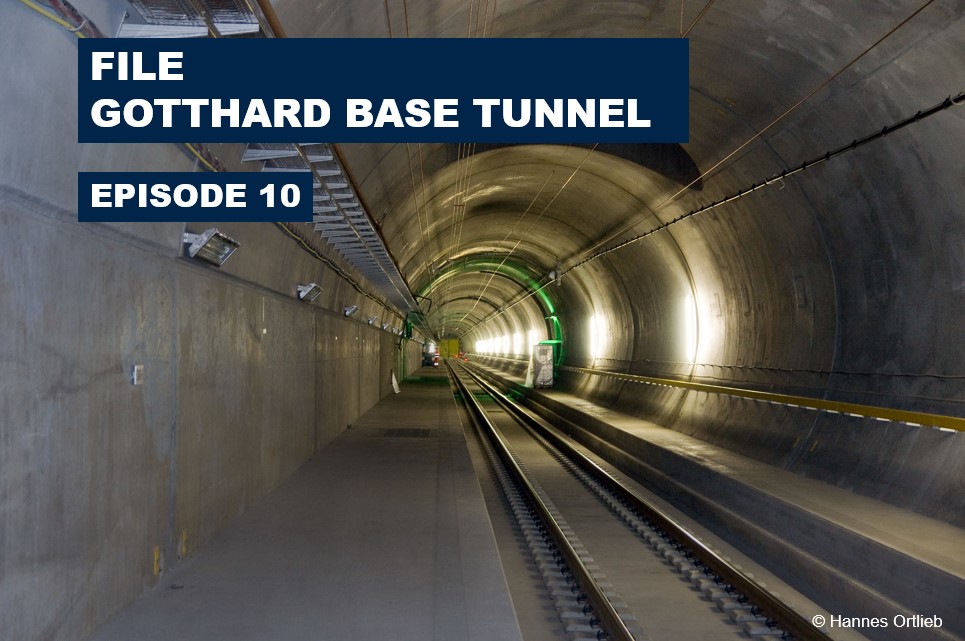In mid-July 2024, the Joint Network Secretariat (JNS) of the European Union Agency for Railways (ERA) published its final report on the accident in the Gotthard Base Tunnel on 10 August 2023. This contains an extended scope of application, an increased operational utilisation limit, stricter specifications for risk control measures and the recommendation of the sound test for prevention.
That’s what it’s all about:
- JNS Task Force publishes final report and impact assessment
- 4 key points for all stakeholders involved: extended scope of application, higher utilisation limit, full implementation of risk control measures, sound test for prevention
- Adapt Annexes 9 and 10 of the General Contract of Use for Wagons
- Prevent misunderstandings in the interpretation of the legal texts
- International follow-up works well
The work of the JNS aims to harmonise all measures taken following an accident or disruption to rail traffic in the EU across the EU (see blog post «Gotthard Base Tunnel (#7): Sust report provides clarity»). The committee is made up of representatives from ERA, the national supervisory authority (NSA) and the Group of Representative Bodies (GRB) representing the international railway associations. The ERA has also published the short analysis «Light Impact Assessment» as a follow-up assessment to the accident in the Gotthard Base Tunnel, focussing on the issue of ‘broken wheels’.
JNS final report contains existing and new measures
The discussions between the JNS and the industry were co-operative. They led to a number of compromises in order to avoid individual national measures announced by several NSAs. Special national regulations jeopardise interoperability and the modal shift envisaged by the EU and Switzerland.
The findings of the final report are based on the recommendations of the JNS ‘Broken Wheels’ process (2017- 2019) and its final report from 2019. Changes compared to the previous report are highlighted in yellow. The supplemented and improved risk control measures completely replace those of the JNS procedure for wheel types BA 004 (‘Crack in the rim’, 2017–2019). The measures for a ‘crack in the wheel disc’ (wheel types BA 314 old/ZDB29) remain valid.
4 Key points for all stakeholders involved
The following aspects are particularly relevant for freight wagon keepers and Entity in Charge of Maintenance (ECM):
- Extended scope of application: The scope of application of the risk control measures has been extended. The list of affected wheel types now includes: BA 004 (also used in some versions of the wheelset type VRY), Db-004sa, BA 390, RI 025, R32, BA 304 and ‘other comparable wheel types that were not part of the JNS assessment’.
- Higher utilisation limit: The operational utilisation limit (see box) for the wheel types concerned has increased from a diameter of 860 mm to 864 mm.
- Full implementation of risk control measures: For all newly affected wheel types, all actors involved must either fully implement the JNS risk control measures or take alternative measures that ensure at least an equivalent level of safety and are justified by a risk analysis in accordance with Annex 1 of EU Regulation 402/2013 (CSM RA).
- Sound test for prevention: The JNS final report lists the sound test as a simple preventive measure to reduce risks. We are of the opinion that railway undertakings should not dispense with the sound test in the event of suspected overheating of the wheelset and/or cracks on the running surface or wheel rim as part of the pre-departure wagon inspection. They should include them in their pre-departure inspection process if they have not already done so.
|
Operational utilisation limit The wheel diameter is not measured before departure or during train preparation. The operational utilisation limit is defined after maintenance. According to the ECM regulation, ECMs must define the appropriate and safe maintenance limit for wheels in order to prevent a wheel of the type concerned from being used below the operational limit of 864 mm during operation. From discussions in the JNS Task Force, the general maintenance limit has been increased from the previous 876 mm to 880 mm after wheelset profiling. Should an ECM decide to allow the use of a wheel with a maintenance limit below 880 mm after profiling, it must prove that this lower maintenance limit (1) guarantees at least the same level of safety, (2) is justified by a risk analysis in accordance with Annex 1 of EU Regulation 402/2013 (CSM RA) and (3) the risk analysis has been reviewed and approved by an independent assessment body, as an installation limit below 880 mm is considered a ‘significant change’. |
Adapt Appendices 9 and 10 of the General Contract of Use for Wagons
The JNS has submitted a recommendation to the Union Internationale des Chemins de fer (UIC), the European Rail Freight Association (ERFA) and the International Union of Wagon Keepers (UIP) as the responsible publishers of the General Contract of Use for Wagons (GCU): The committees should examine the addition of Appendices 9 and 10 to the GCU in order to regulate the detection of thermally overheated wheels even more systematically and uniformly in future.
The debate in the JNS has shown that both the national supervisory authorities of some (EU member) states and railway undertakings are finding it difficult to integrate ECMs into their activities. The JNS therefore recommends that the industry organisations hold clarifying discussions between the Member States and the European Commission and publish guidelines for rail transport companies.
Prevent misunderstandings in the interpretation of legal texts
Together with the UIP, we at the VAP will revisit the role and responsibility of the ECM in the context of the infrastructure manager/rail transport company/wagon keeper responsibility triangle. In doing so, we would like to prevent future misunderstandings about the interpretation of the legal texts among infrastructure managers and railway undertakings as the main players in accordance with the EU Safety Directive and thus also among NSAs. The current discussion in the Swiss parliament on liability in rail freight transport is evidence of the different interpretations of the internationally standardised rail freight transport regulations by various national authorities, European bodies and certain parts of the rail sector.We therefore consider the fact that the JNS has issued the aforementioned recommendation to the industry organisations to be a success of our educational work to date.
International follow-up works well
The final report of the JNS Task Force shows that the harmonised procedures for incidents and occurrences in the rail sector work extremely well at European level.
On the one hand, they allow a broad exchange of experience and, on the other, concrete improvement measures that are supported by the entire industry and all member states.
We will inform you as soon as the final report of the Swiss Safety Investigation Board Sust on the incident in question is available.



